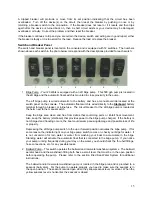
Vented Fuel Fill Fitting
The vented fuel fill fitting is labeled “Gas” or “Fuel” and is located
approximately admidships on the starboard gunwale. Twist the cap to
open the fitting. The cap is connected to the fitting by a chain or cable
so that it will not fall into the water and/or get lost. Be careful not to
pump fuel into any other fitting on the vessel.
While you are filling the tank, fuel entering the tank pushes air in the
tank out through the fuel vent.
Note: Never pump fuel into any fitting, opening or access on the boat unless it is labeled
“Gas” or “Fuel”.
Fuel Sender & Fuel Pick Up
The fuel sender and fuel pick up are accessible via the round deck hatch installed just forward of the
transom. The fuel sender is equipped with a float that moves up and down with the fuel level in the tank.
The fuel level information is sent to the fuel gauge and keeps you informed of the approximate fuel level
in the tank. If you feel that your fuel gauge is reading incorrectly, before considering changing the gauge,
have your Pro-Line dealer’s Service Department or a qualified service professional remove the fuel
sender and check to make sure that the float is able to move up and down freely.
Fuel Water Separator
Depending on your selection of the various optional engine packages, your boat may be equipped with a
fuel water separator for the engine. However, some engines come equipped with a built in fuel water
separator. Please refer to the owner’s manual provided by the manufacturer of your engine package for
operational procedures and for information related to the care and maintenance of their product. When in
doubt, always defer to the engine manufacturer’s instructions and/or recommendations.
If your engine package requires the installation of a fuel water separator, it will be mounted in the bilge on
the inside of the stringer and/or bulkheads. The “spin on” filter cartridge should be renewed every season
at a minimum. Fuel tanks that are not kept full accumulate water faster due to condensation. Therefore,
the filter cartridge may need to be replaced more often depending upon usage and conditions or if motors
begin to run rough. If water should somehow enter your fuel tank via condensation, your fuel source, etc.,
it will become trapped in the fuel water separator before it is able to travel through the fuel system and to
your engine. When replacing the filter cartridge for the fuel water separator, coat the rubber seal with a
film of grease or oil to help prevent sticking.
Please refer to the owner’s manual provided by your engine manufacturer for proper procedures. Some
engines will not have a separate fuel water separator located in the bilge. In this case, the engine
manufacturer will install it in the engine. Check engine specs.
Primer Bulb
Depending on your selection of the various optional engine packages, your boat may be equipped with a
primer bulb. A primer bulb is used to prime the fuel pump in the motor with fuel. Squeeze the primer bulb
a few times until resistance is felt. If no resistance develops and the fuel pump will not prime, you may be
out of fuel, the primer bulb may be defective, or a leak may have developed allowing air into the system.
The primer bulb (if applicable) is located with the rigging tubes where they exit the bilge and are easy to
get to by standing on the dive platform.
Note: Not all engines require primer bulbs. Refer to the engine manual for verification.
24
















































